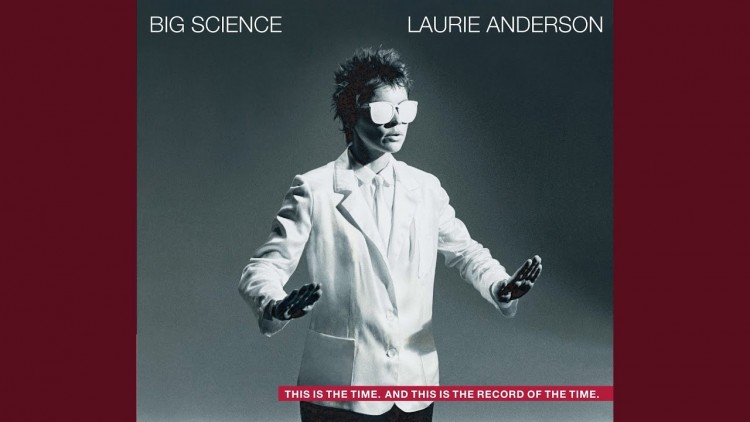Anderson, April 5
On April 5th, Koerner Hall and the 21C Music Festival welcomed back Laurie Anderson, a return visit that skillfully wove together pieces spanning the many decades of her career, while offering a glimpse into future possibilities that AI technology offers. The evening began with From the Air, a track from her 1982 album Big Science, with Anderson's evocative voice delivering instructions as an airplane pilot guiding passengers through a crash landing. This piece set a tone: we were in for a ride with wild bumps along the way. Early on, Anderson shared an anecdote about Yoko Ono's response to Donald Trump's election in 2016, a tweet of a long, extended scream. She invited everyone to join her in a ten-second collective scream for whatever issues weighed on our minds: wars, genocides, climate collapse. Another reminder of life’s fragilities and contradictions came with her performance of one of my favourites: O Superman, also from the Big Science album. The piece contrasts being held in a mother’s arms with other types of arms—military and petrochemical arms, performed while multi-shaped hand silhouettes flashed on the screen.
 Anderson shared her experience at a residency in early 2020 with the University of Adelaide's Australian Institute for Machine Learning where she delved into the artistic possibilities of language-based AI models. Collaborating with the "biggest brain you could imagine," she created a 9000-page document that retold biblical stories in her unique style. She then welcomed local artist David Rokeby onto the stage to showcase Voice Scroll, an AI system being developed at the BMO Lab for Creative Research in the Arts, Performance, Emerging Technologies, and AI at the University of Toronto. The system transforms spoken voice into continually moving visual images to create dream-like scenarios. The demonstration included a sequence of Renaissance portraits of Anderson emerging and transforming across the screen, and concluded with a collaboration with Rokeby narrating a story, Anderson playing the violin, and the screen generating real-time illustrations. Ironically, Anderson's earlier words about technology’s limitations—if you think technology can solve your problems then you don’t understand technology or your problems—were brought to life with a few system crashes during the demo. We will probably see more of this collaboration in the future with a forthcoming residency in the works.
Anderson shared her experience at a residency in early 2020 with the University of Adelaide's Australian Institute for Machine Learning where she delved into the artistic possibilities of language-based AI models. Collaborating with the "biggest brain you could imagine," she created a 9000-page document that retold biblical stories in her unique style. She then welcomed local artist David Rokeby onto the stage to showcase Voice Scroll, an AI system being developed at the BMO Lab for Creative Research in the Arts, Performance, Emerging Technologies, and AI at the University of Toronto. The system transforms spoken voice into continually moving visual images to create dream-like scenarios. The demonstration included a sequence of Renaissance portraits of Anderson emerging and transforming across the screen, and concluded with a collaboration with Rokeby narrating a story, Anderson playing the violin, and the screen generating real-time illustrations. Ironically, Anderson's earlier words about technology’s limitations—if you think technology can solve your problems then you don’t understand technology or your problems—were brought to life with a few system crashes during the demo. We will probably see more of this collaboration in the future with a forthcoming residency in the works.
The evening also included references to recent virtual reality pieces The Chalkroom and To the Moon, collaborations between Anderson and Hsin-Chien Huang. Walking up to the screen with a microphone in hand, it seemed as if she disappeared into a world of floating words, drawings and objects. The concert concluded with Anderson inviting the audience to stand and participate in a group Tai Chi exercise by following her gestures. It was the safe landing she promised as the guiding pilot in the opening song. She reminded us that, as one of her teachers has said, it’s important to be able to feel sad without being sad. “We’re actually here to have a really good time”. Bringing us back to the body and grounding us into a connection with the earth through the movement was a perfect way to end the evening’s ride.
Eve Egoyan, Longing and Belonging
Pianist and composer Eve Egoyan is another artist known both for her innovative approach to expression and her fruitful collaborations with David Rokeby. On May 9th, she will be performing a new program titled Longing and Belonging at the George Weston Recital Hall, featuring compositions by artists from Armenia and the Armenian diaspora. Eve’s personal connection to the Armenian genocide, with both her paternal grandparents being survivors, lends poignant depth to this endeavour. In a significant journey to Armenia in the spring of 2022, she discovered music by Armenian composers, opening up new artistic and emotional ground for herself.
 The program will showcase seven piano works, including Egoyan’s own creation entitled Viva. Inspired by a collection of songs by Komitas Vardapet (1869-1935) , whom she calls the godfather of Armenian music and the most important collector of Armenian folk songs, Egoyan integrates fragments from Vardapet's works into her composition, allowing the delicate beauty of the Armenian folk tunes to shine through without being obscured with traditional Western European harmony. Her composition also blends the acoustic piano with a virtual piano, the software instrument called PIANO NEXT she developed with Rokeby that extends the piano sound using techniques like pitch bend, vibrato, and filtering. The piece features recordings of her daughter Viva's voice, lending a personal touch to the composition.
The program will showcase seven piano works, including Egoyan’s own creation entitled Viva. Inspired by a collection of songs by Komitas Vardapet (1869-1935) , whom she calls the godfather of Armenian music and the most important collector of Armenian folk songs, Egoyan integrates fragments from Vardapet's works into her composition, allowing the delicate beauty of the Armenian folk tunes to shine through without being obscured with traditional Western European harmony. Her composition also blends the acoustic piano with a virtual piano, the software instrument called PIANO NEXT she developed with Rokeby that extends the piano sound using techniques like pitch bend, vibrato, and filtering. The piece features recordings of her daughter Viva's voice, lending a personal touch to the composition.
The program also presents works by contemporary composers from Armenia, Lebanon, the USA, and Germany, each imbued with elements of Armenian folkloric sound. Egoyan describes the music as comprising three distinct threads: a solo, a drone, and a rhythmic drum element. The intricate textures and demands of the compositions challenge the pianist to perform all three elements simultaneously, a departure from traditional piano writing. The evening will commence with a short film by Su Rynard, providing an introduction to each composer's piece and featuring appearances by the living composers themselves, offering a comprehensive experience for the audience.




